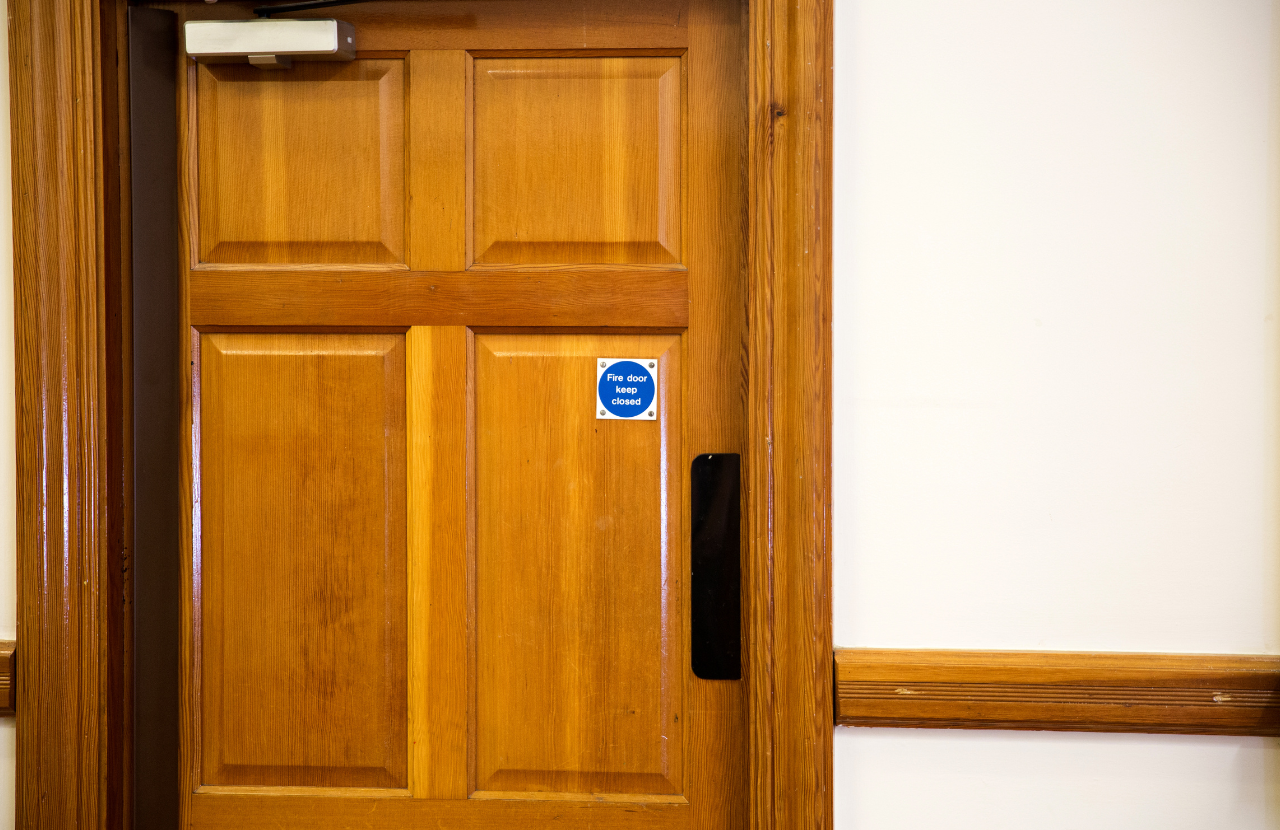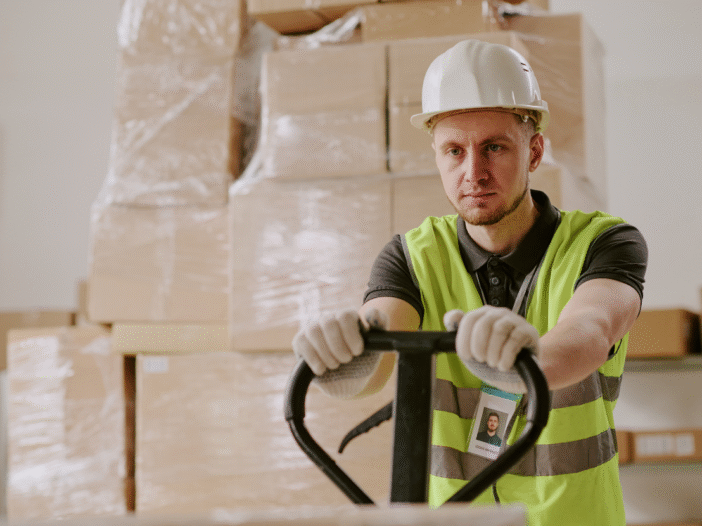
In this guide we answer the question ‘what is the purpose of a fire door?’ explaining how to ensure your fire doors protect lives and meet legal requirements.
What is the purpose of fire doors?
Fire doors are crucial for slowing the spread of fire and smoke, protecting escape routes, and providing valuable time for safe evacuation. By containing fire within a specific area, they help limit damage and safeguard lives.
Fire doors:
- Act as a barrier, allowing people to evacuate safely.
- Help contain fire damage and prevent smoke from obstructing escape routes.
- Divide a building into fire-resistant sections, limiting the spread of flames and smoke.
- Slow the fire’s progress giving emergency responders more time to control the situation.
A fire door is designed to resist fire for a set period, usually 30 or 60 minutes, depending on the rating:
- FD30: Provides 30 minutes of fire resistance.
- FD60: Provides 60 minutes of fire resistance.
It is important to note that there may be other levels of fire resistance.
FD30 and FD60 fire doors are designed to prevent the spread of hot smoke (smoke that occurs at the later stages of a fire), but FD30S and FD60S doors prevent the spread of cold smoke that occurs earlier in a fire.
How do fire doors work?
Unlike standard doors, fire doors are built with fire-resistant materials and components that ensure they remain effective in extreme heat. They are made of fire-resistant core materials, designed to withstand high temperatures for a specific duration, e.g. 30 minutes or 60 minutes.
Fire doors must be fitted with CE-marked, fire-rated hardware to ensure they perform effectively in a fire and comply with UK and European fire safety regulations.
Fire-resistant core
Fire doors are made from solid timber, steel, or composite materials, all of which have strong fire resistance.
Intumescent strips
Fitted along the edges of the door or frame, intumescent strips expand when exposed to heat at a predetermined temperature, sealing any gaps to block fire and smoke from passing through.
These strips are crucial for maintaining compartmentalisation and/or protecting an escape route within a building.
Smoke seals
Smoke seals prevent the spread of toxic smoke through gaps around the door edges, particularly at the top and sides. In the UK, where the cause of death was known, being overcome by gas or smoke was the most common cause of fire-related fatalities, accounting for 32% of deaths in the year ending March 2022.
Usually made from brush strips or rubber-based materials, smoke seals block or expand to seal off smoke when exposed to heat or pressure.
Fire-rated furniture
For a fire door to perform effectively, all its components must be fire-resistant.
Hinges, locks, and latches
Hinges, locks and latches must be fire-rated to show that they have been tested to endure high temperatures without warping or failing. Standard fittings can weaken under heat, compromising the door’s ability to contain fire. Fire-rated hinges are usually installed in sets of three for added strength.
Self-closing mechanisms
Whether surface-mounted or concealed, self-closing mechanisms are essential, particularly in commercial or communal buildings. They ensure the door closes automatically after use, preserving the fire-resistant barrier and helping contain smoke and flames.
Letter boxes
Only fire-rated letter boxes should be used, as they include intumescent liners or flaps that expand in heat, sealing the opening and preventing fire and smoke spread. Non-rated letter boxes must never be fitted to a fire door.
Other essential furniture
Other essential fire-rated furniture includes door viewers, signage, handles, and door closers. All components must be tested, certified, and installed according to the fire door’s specification to ensure full protection.
Door frames
A fire door frame is a vital component of a fire doorset, providing structural support to resist the passage of fire and smoke.
According to the British Woodworking Federation (BWF), the frame’s material and density must match the fire resistance rating of the door leaf. It must be manufactured and installed in line with the fire door manufacturer’s certification or test evidence, as compatibility is crucial. Using an uncertified or incompatible frame can invalidate the fire rating.
Frames should be securely fixed into a fire-resisting wall using steel or fire-rated fixings at certified intervals, with any gaps filled using approved fire-stopping material. The Fire Safety (England) Regulations 2022 specify that the gap between door and frame must be kept as close as possible to 3mm and not exceed 4mm, to ensure intumescent strips and smoke seals function correctly.
Fire-rated glass panels
Some fire doors incorporate fire-rated glass panels to allow visibility while still maintaining fire resistance. These specialised glass types are designed to withstand high temperatures and prevent the spread of flames, smoke, and heat for a specified duration, e.g., 30, 60, or 120 minutes.
There are different categories of fire-rated glass, providing different levels of protection:
- Integrity-only glass (E-rated) prevents the passage of flames and hot gases.
- Integrity and radiation control glass (EW-rated) also limits the amount of radiant heat transmitted.
- Integrity and insulation glass (EI-rated) provides the highest level of protection, blocking flames, smoke, and heat.
All fire-rated glass must be correctly installed and tested as part of a certified fire doorset to ensure compliance and effectiveness.
What are the legal requirements for fire doors?
Compliance with regulations and standards is a legal obligation but, more importantly, vital for protecting lives and property.
Regulatory Reform (Fire Safety) Order 2005
This legislation mandates that the ‘responsible person’ (such as an employer, building owner, or occupier) must implement appropriate fire safety measures in non-domestic premises. A crucial aspect of this duty is ensuring that fire doors are properly maintained and functional.
Article 17 of the Fire Safety Order specifically requires that fire safety equipment, including fire doors, be “subject to a suitable system of maintenance and are maintained in an efficient state, in efficient working order and in good repair.”
Building Regulations (Approved Document B)
Approved Document B specifies where fire doors must be installed in new buildings to ensure safe means of escape and to prevent the spread of fire and smoke.
In walls that separate different buildings
Fire doors are essential in walls that act as fire-separating elements between adjoining buildings. These doors help prevent fire from spreading from one building to another, thereby protecting occupants and property in adjacent structures.
The fire resistance rating of these doors usually matches that of the separating wall, often requiring a minimum of 60 minutes of fire resistance.
To protect stairwells and corridors serving as escape routes
Stairwells and corridors are critical for escape. Installing fire doors in these areas ensures that pathways remain free from fire and smoke for a designated period, facilitating safe evacuation.
The specific fire resistance rating required for these doors depends on the building’s design and intended use.
Fire Safety (England) Regulations 2022
The Fire Safety (England) Regulations 2022 impose specific duties on the ‘responsible person’ in multi-occupied residential buildings over 11 metres in height to enhance fire safety.
Annual checks of flat entrance doors
The responsible person conduct annual inspections of entrance doors to individual flats, focusing on the functionality of self-closing devices.
These checks are vital as flat entrance doors are critical barriers against the spread of fire and smoke from individual units to communal areas. Effective self-closing mechanisms ensure doors close automatically, maintaining the integrity of fire compartments.
The responsible person should document all attempts to gain access for these inspections, even if entry is not granted, to demonstrate compliance efforts.
Quarterly checks of fire doors in common areas
The responsible person is required to perform quarterly inspections of all fire doors located in communal areas, including corridors and stairwells.
Regular inspections help identify and address issues such as damage, wear, or malfunctioning self-closing devices, ensuring these doors function correctly in an emergency. Maintaining detailed records of these checks is crucial for demonstrating compliance and facilitating effective maintenance.
BS 8214:2016 & BS 9999:2017
These British Standards provide detailed guidance on fire door installation and maintenance.
BS 8214:2016 – timber-based fire door assemblies: code of practice
BS 8214: 2016 provides detailed guidance on specifying, installing, and maintaining timber-based fire door assemblies. It covers:
- Design and performance requirements. Guidelines on selecting appropriate materials and construction methods to achieve required fire resistance levels.
- Installation procedures. Detailed instructions to ensure correct fitting, which is essential for the door’s effectiveness in a fire.
- Glazing and ironmongery. Recommendations for incorporating fire-resistant glazing and hardware components, such as hinges and locks, to maintain the door’s integrity in a fire.
- Maintenance practices. Advice on regular inspections and upkeep to ensure ongoing compliance with safety standards.
BS 9999:2017 – fire safety in the design, management, and use of buildings: code of practice
BS 9999: 2017 provides a comprehensive framework for fire safety, integrating fire door specifications into the broader context of building design and management.
Key aspects are:
- Risk assessment approach. Using risk profiles to develop fire safety strategies, ensuring fire door installations are suited to the building’s specific requirements and the needs of its occupants.
- Design guidance. Providing adaptable design solutions that consider factors such as building occupancy and usage to ensure effective fire safety measures.
- Management responsibilities. Emphasising the importance of ongoing fire safety management throughout a building’s life cycle, including regular maintenance and inspection of fire doors.
Compliance with BS 9999:2017 ensures that fire doors are integrated effectively into a building’s fire safety strategy.
What if fire doors do not meet modern fire safety standards?
In older buildings, some fire doors may not have a visible certification label or plug from recognised bodies like Certifire or BM TRADA. These are often referred to as ‘nominal’ doors. Although they are not officially certified, they may not need to be replaced.
It is important to assess whether a nominal door is still suitable for its location. For example, a solid timber door around 44mm thick, especially if it includes combined intumescent and smoke seals, could offer a similar level of protection to a certified FD30 fire door.
If a nominal fire door is not suitable but replacing it with a certified fire door is not feasible, additional safety measures may be needed, such as upgrading escape routes or installing fire detection systems to compensate for reduced protection.
Fire door maintenance and inspections
Regular fire door inspections and maintenance are essential for ensuring they function correctly in the event of a fire. Fire doors should be checked by a competent inspector to identify any issues that could compromise fire safety.
Under the Regulatory Reform (Fire Safety) Order 2005, a competent person is defined as someone who has ‘sufficient training and experience or knowledge and other qualities’ to properly assist in implementing preventive and protective fire safety measures.
In addition to formal inspections, basic fire door checks should be carried out regularly. These include ensuring there are no gaps exceeding 4mm around the door, that self-closing mechanisms work correctly, and that intumescent and smoke seals are intact. Hinges, locks, and other essential components should also be secure and undamaged.
Maintaining detailed records of fire door inspections and corrective actions is crucial for compliance with fire safety regulations.
For a more detailed guide and a free inspection checklist, please read our article: How often do fire doors need to be inspected?
Ensure your fire doors are compliant and protect lives
What is the purpose of a fire door? Fire doors are crucial for protecting lives, reducing property damage, and ensuring legal compliance by slowing the spread of fire and smoke. However, to remain effective, they must be regularly inspected and properly maintained.
At Praxis42, our fire door inspection service ensures your fire doors meet UK fire safety regulations. Our certified fire specialists conduct detailed assessments, identifying non-compliance issues and providing clear recommendations to keep your building safe.
Contact us today on 0203 011 4242// info@praxis42.com to find out more or schedule an inspection.

Rob Sherman
Director of Fire Safety
